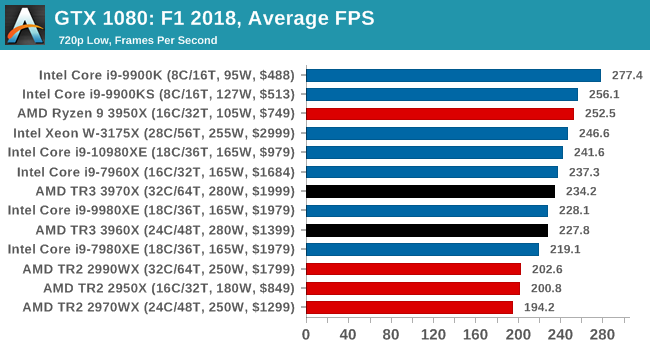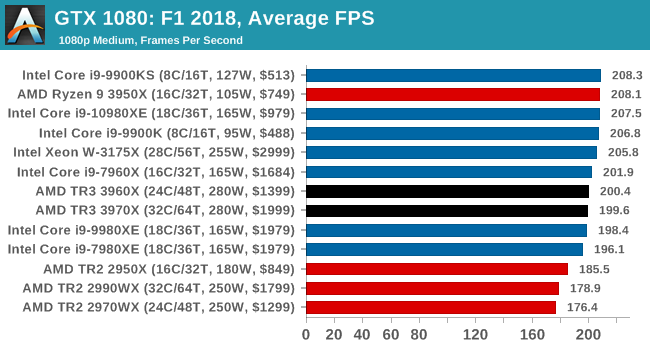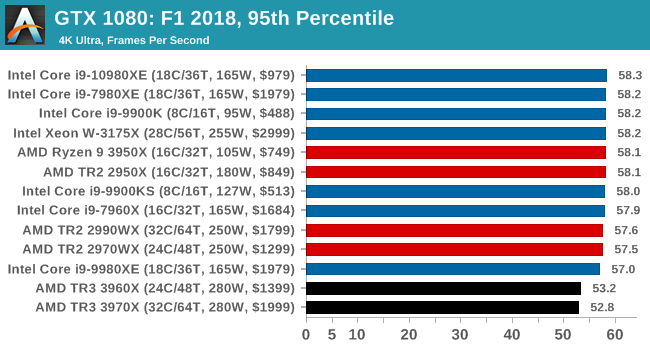The AMD Ryzen Threadripper 3960X and 3970X Review: 24 and 32 Cores on 7nm
by Dr. Ian Cutress, Andrei Frumusanu & Gavin Bonshor on November 25, 2019 9:05 AM ESTGaming: F1 2018
Aside from keeping up-to-date on the Formula One world, F1 2017 added HDR support, which F1 2018 has maintained; otherwise, we should see any newer versions of Codemasters' EGO engine find its way into F1. Graphically demanding in its own right, F1 2018 keeps a useful racing-type graphics workload in our benchmarks.
We use the in-game benchmark, set to run on the Montreal track in the wet, driving as Lewis Hamilton from last place on the grid. Data is taken over a one-lap race.
All of our benchmark results can also be found in our benchmark engine, Bench.
| AnandTech | IGP | Low | Medium | High |
| Average FPS |  |
 |
 |
 |
| 95th Percentile |  |
 |
 |
 |












245 Comments
View All Comments
Silma - Monday, November 25, 2019 - link
Not.Congrats to AMD on great processors, but the consumer market for $1,4-$2k processors is super tiny.
Despite the current generation of AMD processors for desktops being arguably superior to those of Intel, in the financials, Intel still destroys AMD and it is indeed a bloodbath.
In my opinion, AMD would hurt Intel much more, and in the end earn more money, if it priced its offerings lower, for consumer processors as well as datacenter processors.
sgeocla - Monday, November 25, 2019 - link
Not that small.>> Workstations are a growing market segment and have been for quite some time. They run 24-7, are extremely reliable, and have features and specifications you can’t find in a PC. Therefore, workstations can command high price points because of the high expectations users have for them. Our research shows the market size for workstations is approximately 5.3 million units, about 2% of the total PC market, and brings in over $10 billion dollars a year, almost 2.5% of the PC market total, which indicates the average selling price (ASP) is higher than the ASP of a PC.
https://gfxspeak.com/2019/05/13/stands-for-worksta...
melgross - Monday, November 25, 2019 - link
Very small. The more cores, the smaller the market. What are so many cores good for? Video editing, huge databases. Financial transactions, which the chips are not likely to be used for.For most everyone else, 8 cores is still the sweet spot.
ShowsOn - Monday, November 25, 2019 - link
The review literally discusses this point:"...Intel has reported that the workstation market has a potential $10B a year addressable market, so it is still worth pursuing. While I have no direct quotes or data, I remember being told for several generations that Intel’s best-selling HEDT processors were always the highest core count, highest performance parts that money could buy. These users wanted off-the-shelf hardware, and were willing to pay for it – they just weren’t willing to pay for enterprise features...Now that we can get better performance at $1999 with 32 cores, assuming AMD can keep stock of the hardware, it stands to reason that this market will pick up interest again."
twtech - Monday, November 25, 2019 - link
They need to partner with a workstation vendor such as Dell, HP, etc. - or pick/create a company to partner with. Big businesses like to have a reliable single vendor they can deal with for all their server and workstation hardware, including support.eek2121 - Monday, November 25, 2019 - link
They really need Dell.xrror - Tuesday, November 26, 2019 - link
Sadly Dell always seems anti-AMD - or I guess more accurately they absolutely will not do anything that could jeopardize receiving Intel's contrarevenue.eek2121 - Monday, November 25, 2019 - link
Pretty much anybody that does graphics, video, etc. has a need for these CPUs. A large portion of professional Youtubers use blender or similar applications (that scale perfectly) to render things like 3d animations and the like. On the contrary. The market for these types of CPUs is larger than the gaming market. AMD's biggest obstacle here is getting prebuilt OEM systems built with sufficient cooling. Not many folks in that audience are going to build their own PC.melgross - Monday, November 25, 2019 - link
Nope. Graphics apps don’t use all these cores. I run that stuff. Neither do apps like Photoshop. If sometimes they use most cores, the usage ore core I’d down around 20% in spurts. Fewer cores simply have higher per core usage.As I said, video rendering is about the only thing that most users will find using a lot of cores. Even multasking doesn’t use 16 or more cores efficiently.
It’s also interesting that years ago, the argument was too much power. 150 Watters was considered to be on the high side, and not in a good way. Now these cores are moving to 300 watts, and nobody is saying anything.
Jimbo Jones - Tuesday, November 26, 2019 - link
Video rendering3D rendering
3D animation where physics calculation is need (cloth, particles, etc)
Particle simulations for 3D animation / work / science
Game creation / compiling / baking
Progamming (compiling)
VFX -- after effects, etc
Gaming while rendering out any of the above at the same time
Doing more than one thing at a time (Intel users close all their apps to game, lol)
Gaming while streaming
Youtube content creation (requires video rendering and encoding)
Digital audio workstations
To name a couple ...
I actually read someone on another comment feed defending Intel by saying "CPU's aren't even important these days anyway!" -- the desperation of fanbois to grasp at straws to defend the indefensible is hilarious ... right Mel?